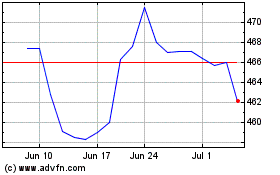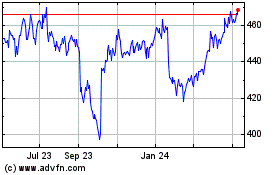Lockheed Martin Says Protracted F-35 Contract Talks Weigh on Cash -- Update
July 19 2016 - 2:35PM
Dow Jones News
By Robert Wall and Lisa Beilfuss
Protracted contract talks between the Pentagon and Lockheed
Martin Corp. over the next batch of F-35 combat jet planes are a
drag on the military contractor's cash and could force it to take
out extra loans to keep paying suppliers, the company's chief
financial officer said.
Negotiations over the multibillion-dollar, 160-aircraft deal
have been dragging for months as the sides haggle over what it
costs to build the planes. Absent a contract, Lockheed Martin has
been using its own money to keep production going.
"We will not be able to continue and have that level of cash
outflow," Lockheed Martin Chief Financial Officer Bruce Tanner
Tuesday said as the Pentagon's biggest arms supplier by sales
reported second-quarter earnings.
Lockheed Martin hopes to complete the contract or get an
alternative funding arrangement to help recoup cash before
year-end, he said, having fronted $900 million.
If Lockheed Martin were forced to continue paying suppliers out
of its own pocket, it may have to turn to commercial lenders to
help finance the payments, Mr. Tanner said. That would entail
higher cost which, he suggested, could also impact the
government.
The government's F-35 program office couldn't immediately be
reached for comment.
The F-35 Joint Strike Fighter is the Pentagon's most expensive
weapons program. The stealthy combat plane also is being bought by
a number of other countries, including the U.K., Israel and
Turkey.
Lockheed Martin Chief Executive Marillyn Hewson said she didn't
see the failed coup attempt in Turkey over the weekend harming the
company's business prospects there. "We have not seen any
indication it will impact the F-35 or any of their other programs,"
she said on an analysts call.
Despite the cash concerns on its biggest program, Lockheed
Martin further lifted its forecast for the year as the company
logged higher F-35 jet fighter deliveries and benefited from sales
in its recently acquired Sikorsky helicopter unit. It still
generated $1.5 billion cash from operations in the period.
In its latest quarter, the company said higher F-35 sales pushed
revenue in its aeronautics business, its biggest, up 5.9% to $4.38
billion. Meanwhile, revenue in its mission systems segment surged
53% thanks to Sikorsky. Performance in those two segments offset
lower sales in the company's IT and space systems businesses.
Overall, Lockheed reported a profit of $1.02 billion, or $3.32 a
share, up from $929 million, or $2.94 a share, a year earlier.
Revenue increased 11% to $12.91 billion.
Analysts anticipated $2.93 in earnings per share on $12.55
billion in sales.
Maryland-based Lockheed has been working to reshape its business
as it looks to focus on more profitable work building military
jets, helicopters and missiles. Last year Lockheed bought
helicopter maker Sikorsky Corp. for $9 billion, and it said earlier
this year that it would divest its big government
information-technology unit and merge it with Leidos Holdings Inc.,
a deal the company said Tuesday is on track to close in the third
quarter.
For the year, Lockheed now expects to report $12.15 to $12.45 in
earnings per share, up from an earlier prediction of $11.50 to
$11.80 a share. The company expects to log $50 billion to $51.5
billion in revenue this year, higher than its previous $49.6
billion to $51.1 billion forecast.
Write to Robert Wall at robert.wall@wsj.com and Lisa Beilfuss at
lisa.beilfuss@wsj.com
(END) Dow Jones Newswires
July 19, 2016 14:20 ET (18:20 GMT)
Copyright (c) 2016 Dow Jones & Company, Inc.
Lockheed Martin (NYSE:LMT)
Historical Stock Chart
From Mar 2024 to Apr 2024

Lockheed Martin (NYSE:LMT)
Historical Stock Chart
From Apr 2023 to Apr 2024
